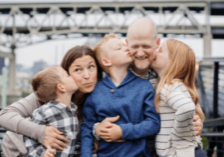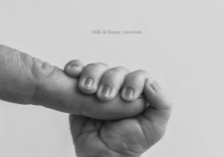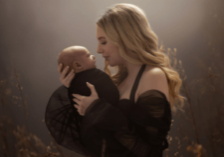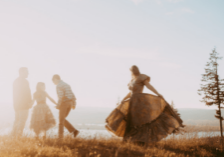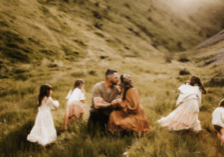Stop Selling Yourself Short: How to Price and Market Yourself to be a Profitable Photographer with Jenny Cruger and Alison Craig of The Profitable Portrait Society
Between the two of them, Jenny and Allison have decades of experience as luxury photographers. And this year, after being friends and colleagues for much of that time, they’ve finally launched a brand new program together to empower photographers to take control of the business side of their work.
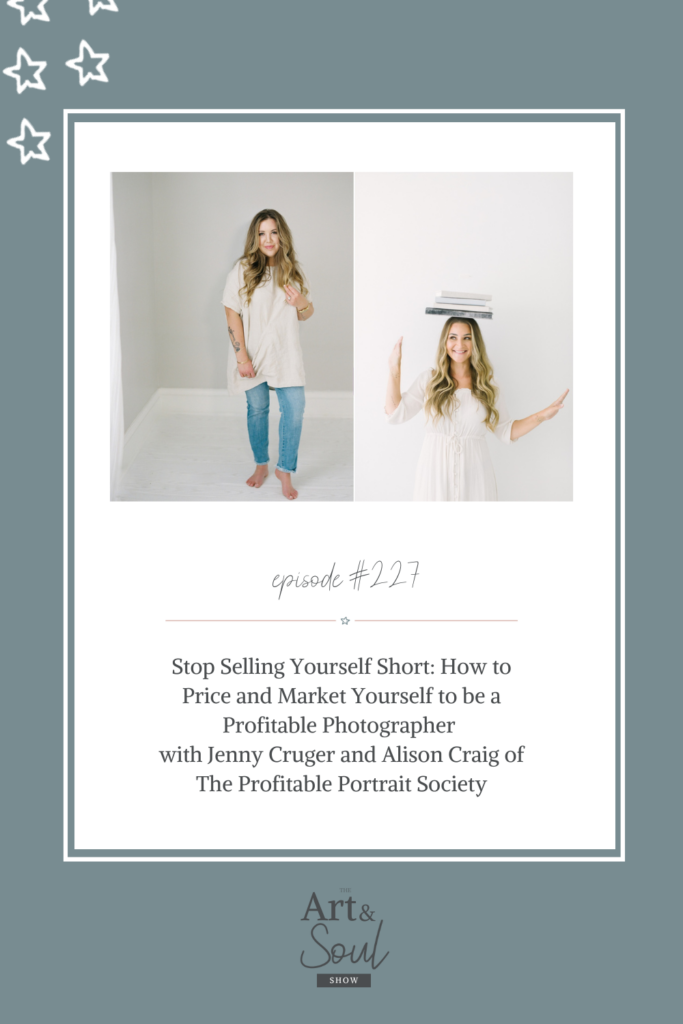
In this episode, Lisa sits down with Jenny and Allison to chat all about what exactly The Profitable Portrait Society is, some of the biggest hurdles they see photographers face over and over again, and how to break through the pricing and marketing mindset issues that keep many photographers unprofitable.
No matter where you are in your photography career, this episode is going to give you some food for thought! Let’s dive in!
What’s in this episode:
- [02:29] How Jeny and Allison started working together and how The Profitable Portrait Society was born
- [05:38] How to break out of the head-in-the-sand mentality when it comes to your pricing as a photographer
- [13:08] Why photographers get lost in “busy work” and how to break out of that cycle
- [21:26] What marketing should actually look like for a photographer (hint: it’s not one boosted FB post)
- [36:49] How creatives and photographers can avoid burnout while balancing the constant need to market and create content
- [49:13] The best business advice Jenny and Allison have received
Tune in to this episode for a little kick in the pants to start running your photography business like a real business!
SUBSCRIBE: Apple Podcasts | Spotify
Want to put an end to awkward moments in your photo sessions and create genuine connection? Download The Storyteller’s Toolkit today, featuring 200+ emotive photography prompts, so you’re never left wondering what to say.
Meet Jenny Cruger and Allison Craig
Best friends Jenny and Allison have taught together since 2015, partnered at The Motherhood Anthology for 8 years, and organized numerous retreats and workshops.
New in 2024, The Profitable Portrait Society (TPPS) arose from a desire for simplicity in business education. Jenny and Allison consistently emphasize core principles in their teachings, offering clear, practical guidance on pricing and success without unnecessary complexity.
With over 21 combined years of teaching experience and 26 years running successful portrait businesses, Jenny and Allison are dedicated to helping photographers price their services profitably, celebrate their successes, and thrive. They love making a positive impact on the industry and openly share their own mistakes so others can find success more quickly and easily.
Meet Jenny and Alison
Visit the Profitable Portrait Society website
Join the TPPS group on Facebook
Did this episode help you rethink the way you think about finding success through creativity? Check out this episode Practicing Presence: The Healing Power of Slowing Down & Tuning into Mindfulness & Creativity in Photography with Joy Prouty that shares how another photographer started their career!
Transcript
[00:00:00] Jenny: We work way too hard to just break even or make a teeny tiny salary. Like, like Allison said, if you can make more working at Costco, at Starbucks, clock in and out and be done, you’re better off. Because it’s our own business and because it’s our art combined, it’s so emotional and we put so much into it.
[00:00:21] Even if you are only doing a few sessions a month or something, it’s still that emotional artist vibe that you’re putting into it. It should cost money.
[00:00:35] Lisa: Hey friend! Welcome to the Art and Soul Show. I’m your host, Lisa DeJeso, a mom, a photographer, and entrepreneur. Tune in here for pep talks, conversations, and advice on photography, creativity, mindset, business, life, and that messy in between. This is the place where you can go when you need a boost of encouragement, a kick in the pants, and inspiration to pick up your camera.
[00:00:57] This is the art and soul show. [00:01:00] Hello, my beautiful friends. Welcome back to the show today. I’m super excited to dive into today’s conversation with Jenny and Allison, best friends and business partners. They’ve been teaching together since 2015 and spent eight years collaborating together at the motherhood anthology throughout their journey.
[00:01:18] They’ve organized numerous retreats and workshops. Aimed at helping photographers succeed. Well, in 2024, they launched the profitable portrait society driven by their passion for making business education, simple and accessible. Their approach emphasizes clear, actionable guidance, particularly in pricing and business growth, with a focus on eliminating unnecessary complexity with over 21 combined years of teaching experience and 26 years running successful portrait businesses.
[00:01:45] Jenny and Allison are dedicated to helping photographers, Price their services profitably, celebrate their successes and thrive. They love making a positive impact on this industry and they openly share their own mistakes so others can find success [00:02:00] more quickly and easily. I think I’ve known Jenny for probably about 10 years now, and Allison’s going to be a new friend of mine too.
[00:02:06] And I am so excited to dive into this conversation. These ladies are so full of knowledge and I’m really excited what they’ve got coming up. with their profitable portrait society. So welcome, Jenny. Welcome, Alison. Thank you. So can you share a little bit how your partnership began and sort of what inspired you to start working together in the photography industry?
[00:02:29] Jenny: Yes. So Alison likes to say that she made me be her friend. So I was teaching on my own for a few years and she had purchased one of my online, like education courses. And we just. Basically, she made me be her friend, so we became really good friends. We founded the Motherhood Anthology together in 2015 and just kind of continued my teaching and then added her teaching with me through that.
[00:02:58] So that’s [00:03:00] kind of what kicked off it all, but yeah, she likes to tell people. She’s the extrovert. I’m the introvert. I love it. So she just forced me along on that journey. It worked out okay. I love it.
[00:03:10] Lisa: I love that. I have a business partner myself and it is, it is so nice to have. A yin to yang and like, just have that other person that running mates, you always have that person to like, just bounce those ideas off and like get excited about things with.
[00:03:24] So I love that. I love, I love meeting others that have really great partnerships and obviously a proven one because you’re continuing to do something new together. So can you share a little bit what the inspiration launching the profitable portrait society was in 2024 and maybe any gaps in the industry you want to fill with this new venture?
[00:03:41] Sure.
[00:03:42] Allison: Yeah, I think we just saw that, like, the industry was becoming, like, bigger and bigger and bigger with, like, the things that you need to do to have a profitable business or the things that you have to do to have this experience. And really, it’s not that [00:04:00] hard. We really wanted to take it back down to the basics of what you need to do in order to have that business.
[00:04:08] And it all really comes down to like three simple things. The marketing, the branding, the pricing. And we wanted to like show people that it’s not, well, it isn’t hard. It just takes a lot of dedication and effort. And yeah, that’s how it was born.
[00:04:26] Lisa: I love that. One thing that photographers are. Um, and one of the things that we’re really stellar at is we would like to overcomplicate things.
[00:04:32] So do you find that with your students, you find specifically certain areas that they like to overcomplicate? And if so, what is it?
[00:04:39] Jenny: Yeah, I was going to say, we just constantly are overcomplicating everything in life. Right. But like, especially. Our photography businesses when really like, I think pricing is probably the biggest people are doing all these crazy things and like, Trying to look at every photographer in their city or compare like, okay, well.
[00:04:58] I’ve been doing it [00:05:00] this many years. They’ve been doing it this many years. So like, I should be like somewhere in here. It’s like, all you need to do is do your cost of doing business. There’s definitely different pricing structures that you can use, but bare minimum, like you just need to know that number based on your expenses, your salary needs, your taxes.
[00:05:19] And I just feel like people make that so complicated, but it’s just math. It’s just math. And so if you start there, then you can kind of start. What do I want to sell? How do I want to sell it? Things like that. But we don’t need to look at 50 other photographers within a 10 mile radius to figure out like what you should be doing, because number one, most photographers aren’t profitable anyways.
[00:05:40] So like, if you’re looking at all those people, probably most of them aren’t even making money. So don’t, don’t model your business after them anyway. Yeah,
[00:05:48] Lisa: that’s so true. Okay. So with pricing, one thing photographers love to do is bury our heads in the sand and ignore overspending undercharging and [00:06:00] just kind of stay there and continue to sort of perpetuate this unprofitability.
[00:06:06] So if you have a client or a student that is in that position where they’re just kind of keeping their head in the sand, how do you get them to pop out of that?
[00:06:15] Allison: I think that The best way is we do this exercise on the weekends on our Instagram where we ask them for how many sessions they want to do a year, what their expenses are, what their desired salary is, and we do a really rough, quick cost of doing business.
[00:06:34] And oftentimes that’s the aha moment where if a really rough cost of doing business shows that they should be, charging, let’s say 1200 and they’re actually charging 400. That’s their like, Oh, moment. And we always say math doesn’t lie. Like you can’t argue with the numbers. So once you know, then you can either choose to adjust something so you [00:07:00] can lower your expenses.
[00:07:01] You can increase the number of sessions that you do, but like only so much before you burn out. You can lower your salary, but. To what point, right? Like you could really then just go work at Costco and make more, or you can choose to raise your prices. And then from there, that’s where we support them and help them brand and market themselves to reach that ideal client.
[00:07:22] That’s going to pay what they’re asking.
[00:07:26] Lisa: One thing that I often see is money blocks with students because it’s like, you hear my clients will never pay that, or. I live in an area where it’s really blue collar, so there’s no luxury photography. What do you say to someone who maybe is in this position where they want and they need to raise their pricing, but they don’t believe that anyone will pay it?
[00:07:47] Jenny: I have a
[00:07:48] Lisa: really good story.
[00:07:49] Jenny: This is actually pretty wild because you’re right. Like we hear that all the time. Like people will see my prices, Allison’s prices, anybody’s like profitable prices and say like, [00:08:00] Oh, that’s so great for you. Like, that’s so cool. Good for you. I could never charge that where I live and I guarantee no matter where you live, everybody, if you’re a photographer, you have potentially said that before about your location.
[00:08:13] So first of all, yeah, realizing that like, that’s the same everywhere. Like everybody feels that way, but. I’m in like a few different photography, like Facebook groups, a lot of them focused on business and pricing and stuff like that. And we just, there was one discussion one day, this is probably a year or two ago.
[00:08:32] And somebody was just going back and forth, like, same thing. That’s great for you, but I could never charge that where I live. Like you don’t understand, blah, blah, blah, blah. Like on and on, like defiant about it. And I’m like, yeah. Yes, it is possible that you might live in a lower cost of living area, so your needed salary could be lower than mine, so yes, your prices could be a little bit lower, but they still have to be profitable in reference to what your salary needs [00:09:00] are and what your cost of living needs are.
[00:09:02] So we’re going back and forth and I’m like, I promise you you can charge more. Like she was charging so little. Finally, I was like, okay, maybe she’s right. Like maybe I’m crazy. So I look up where she lives, her, her business didn’t have a commercial studio. So she was using her actual like home address and city.
[00:09:21] Her front door was 20 minutes from my front door. I mapped it and I was like, what? I was like, no, I’m like, Oh, you have, you have chosen the wrong person to have this, like, to go down this pathway because, and actually, right. I was like, Oh, we are even in more, more deeper here now. But, and that just shows that I think to circle back, a lot of people think that they have to market to their tiny little hometown when you might live an hour from a major city.
[00:09:53] I live about 35, 40 minutes from Nashville. My studio is about 20 minutes South of Nashville. [00:10:00] So it’s like in between Nashville and my actual house, you know, and she was 20 minutes from my house. So there’s no reason that she. should not be marketing to the exact same city and clients that I could be marketing to.
[00:10:12] Now I’m not saying you have to be the most high end luxury photographer in your area, but if you’re within a couple hours of a city, there’s no reason that you can’t charge bare minimum profitable rates.
[00:10:25] Lisa: I love that. So once you got through that, tell me what happened. Did she change her pricing? Probably not.
[00:10:32] Jenny: I don’t know. Yeah. Those
[00:10:34] Lisa: money blocks
[00:10:34] Jenny: are deep. It is deep. And it’s hard because money is relative. What a hundred dollars feels like to me might be different than what a hundred dollars feels like to you. Or even I always say like when I started my business about 14, 15 years ago, a hundred dollars to me then in my bank account, that was groceries for the whole month.
[00:10:54] That was sometimes we would have weeks with just a hundred dollars left. Like we were [00:11:00] struggling and now, you know, not that a hundred dollars is nothing, but it’s just not the same as it was for me. When I started my business and the only way you can get there is to have a profitable career, give yourself a profitable salary.
[00:11:17] Lisa: It’s great. That’s great advice. I think one thing that a lot of, especially those in that sort of middle ground where they’re not overly profitable or they’re just tiny little bit of profit is they end up seeing all of these because we’re maternity photographers. We, you see all of these gorgeous gowns, you see all these newborn outfits, all the new blankets, the tie backs, all the props.
[00:11:38] And the overspending to create all these, you know, we have these client closets and all the, all these things, but they can’t afford them. And so they’re taking all of that money that could be, you know, actually as their profitable business and we’re putting it back into our business, but overspending.
[00:11:58] And it’s just like, then it gets to the [00:12:00] point where you’re like, why are you even doing this then?
[00:12:02] Jenny: Yeah, we work way too hard to just break even or make a teeny tiny salary like, like Allison said, if you can make more working at Costco, at Starbucks, plocking it out and be done, you’re better off. Because it’s our own business and because it’s our art combined, it’s so emotional and we put so much into it.
[00:12:23] Even if you are only doing a few sessions a month or something, it’s still that emotional artist vibe that you’re putting into it.
[00:12:31] Lisa: It should cost money. It should, it should be a value. And, and that time away from your family. Yes.
[00:12:37] Allison: Yeah. And we always say too, that like, it doesn’t matter if you’re doing one session a month or 10 a month, you still have those.
[00:12:46] foundational expenses, which are the insurance, the subscriptions to your CRM, like all those things that you have to pay for, you pay for them, whether you have one or 10. [00:13:00] And so you, you look at that and you’re like, okay, like, I, I really do need to be profitable. Like I do.
[00:13:08] Lisa: I love it. I love this conversation.
[00:13:12] So let’s talk a little bit about getting lost in the In the business, working on maybe unnecessary tasks and spending all of our time doing that, where it’s not actually moving your business forward. So what tasks do you find that maybe students get lost in instead of actually working on their business to get more clients that will pay what they want and, you know, Be profitable.
[00:13:36] Jenny: Yeah. Allison is like our workflow queen, so I’m going to let you punch at that one.
[00:13:43] Allison: Oh man. So we just did this, I guess you would call it an exercise. It’s called momentum. We did this inside of the Profitable Portrait Society and it really focused on not getting lost in these mundane tasks. And I, I don’t necessarily [00:14:00] feel like as a business owner, right.
[00:14:03] You know, there’s a lot of things that we take a stab at that aren’t necessarily like not a good idea. But if you do them not in a good order, or like you do a little bit of this and a little bit of that, and it’s not organized, then it doesn’t make a difference in your business. And so what we realized is.
[00:14:26] If you really block your time, if you’re really organized with your workflows, if you’re really intentional in what you’re doing, that’s when all of those tasks that are unorganized become really something that moves the needle. So what we say to do is seven before 11. And so you’re picking seven tasks and getting them done before 11 a.
[00:14:48] m. And that for us was a huge game changer for a lot of members inside because it really got you to sit down and write down. What can I do this morning? [00:15:00] That’s gonna, you know, make a really big difference in our day for me I also do I have like a pad right here on my desk. I do my top three for the day So not just seven tasks, but also like what are my big three for the day that I really need to get done workflows, I know that so many photographers have CRM’s like 17 hats or What are the other ones do Posado all those but they don’t really implement a workflow.
[00:15:25] They don’t at all You They don’t. And for me, that was the biggest game changer and saving time in my day. Like I have the inquiry workflow. I have the session workflow and I have the post session workflow and just being able to apply that to clients. And it reminds me of what to do. It tells me what email to send.
[00:15:48] It keeps me on track that saves hours in my day. So I think that. Because so many artists aren’t really business minded, they really [00:16:00] need to utilize the business systems that have been given to them. It’s worth a setup. And It will save them so much time and effort and energy.
[00:16:11] Lisa: Is there a system that you’re using for an organized workflow?
[00:16:16] Allison: Yeah, I use 17 hats. That’s what I know and love. And then I also have a good old spreadsheet. I feel like sometimes, you know, sometimes a good old spreadsheet really does keep you on track. So I have that just because I have an employee also that Is doing sessions whenever I’m not in Houston, and so we have that that just shows like the client and when it’s when the gallery is do and every little step along the way so that we can both see it.
[00:16:45] That’s that’s sometimes a good old spreadsheet is really what you need.
[00:16:50] Lisa: I used to be an event coordinator and. having to organize multiple events. And like I am by nature, not overly organized. My family found it [00:17:00] so shocking that I was an event planner because I’m literally, I was like the least person that you would have expected to do this.
[00:17:06] But I had to come up with all these ways of like remembering all these steps for each client.
[00:17:12] Jenny: And
[00:17:12] Lisa: so I took that. And when I started my photography business, I would make these little spreadsheets and I would call them client trackers. So if I had like 14 clients in October, I would have like their name, I’d have when their session was, if I did their sneak, like all of like the thing.
[00:17:27] That’s what mine is. And like, and then just check it off. So you’re like, okay, so that’s what I did with this person. And so you know, and like when, if I told them it was going to be due in three weeks or four weeks, I’d have like the due date. And so it kept me really organized. And I actually, cause I’m old school, I had to do it like on paper printed out and I’d have it and then just check it off.
[00:17:47] But it was like, The only way I could stay organized. So I always think of workflow. I always think it’s like, I like to overcomplicate it. And I think it’s like this great big thing that this has this massive system, but it can be just as [00:18:00] simple as having that one piece of paper that keeps you like organized, right?
[00:18:04] Allison: Yeah. Yeah. That’s literally my worksheet or like my, My, my Google sheet is like, have I done a sneak? Have I uploaded their gallery to pick time? Have I scheduled their ordering appointment? Have I ordered their proofs? Like all of these little things that I just check off to keep me on track.
[00:18:21] Lisa: Yeah. It’s my brain.
[00:18:23] Right. Exactly. And I, like I have ADHD. Well, I’m undiagnosed, but I’m assuming that I do have it. So like having something that was a simple system. Because if you give me a complicated system, my brain will just glitch and I will find ways to like break the system and sabotage it.
[00:18:36] Allison: Yes. So
[00:18:39] Lisa: I’m right there with you.
[00:18:42] I love it. So marketing can also be something that’s super overwhelming for photographers. So when it comes to marketing, what are some effective strategies that attract and retain clients?
[00:18:53] Jenny: So I, you may have heard me say this before, but for years, I’m like photographers need to [00:19:00] think about marketing as like a puzzle.
[00:19:01] And. Maybe your puzzle looks different than mine. There’s all these different puzzle pieces, but you have to do multiple different marketing things as pieces of the puzzle. And you have to do them consistently continually. I think a lot of photographers will see that, you know, somebody recommends hosting on social media for marketing.
[00:19:22] So maybe like, you know, for Alison and I both Instagram, we do get a lot of inquiries from Instagram. And so you could hear us say like, Post on Instagram, and they might go do that for a week or two and be all in and posting and then just trail off and completely ghost their own Instagram account. And number one, Instagram does not like that.
[00:19:44] Yes. I mean, I think we’ve all been guilty of that. We like to say that we’ve learned a lot of these things the hard way, so we’re not gonna say we’ve never also done these things that we tell you not to do. But yeah, like, Instagram wants you to be consistent. Thanks for listening. Same for Google. They [00:20:00] want you to be consistent.
[00:20:01] You need to have good SEO. That’s huge for people finding you even I would say over social media because for me like somebody could be seeing somebody else’s, a friend’s, you know, image on Instagram, but they’re not really in the mindset to be hiring somebody, or they could be scrolling and just come across your work, which is great.
[00:20:21] Like that may also work that could turn into a client in the long run. But if somebody is Googling Nashville, newborn photographer, they’re probably ready to hire somebody like they’re likely a little more serious, likely a little more of a warmer lead because they’re, searching that out. And so you really want to be, be able to come up at the top of Google, have good SEO, and then your website has to support that also good SEO is great.
[00:20:49] But if your brand and your visual branding and your copy on your website and even your image quality, like that all goes into How somebody feels [00:21:00] when they, then when they land on your website, that has to be airtight. And again, it’s simple when we say it, but it can be hard to like really find yourself and know, like what you want your brand to be and like who you want to speak to.
[00:21:15] And that’s where you really have to dig deep and figure out those things, decide on those things, and then figure out how to, how you can represent those things. You know, in the wild
[00:21:26] Lisa: love that I think a lot of time photographers get confused on what marketing actually is Yeah, like I think it’s maybe just I post once on Instagram that I’m having fall minis And then they hear crickets and they’re like, but I did marketing.
[00:21:41] Yeah. And
[00:21:43] Jenny: you did
[00:21:43] Lisa: marketing for one day marketing or they boost, uh, you know, they throw some money at a boosted Facebook post and call it a day. Right. So what advice do you have for someone who maybe is thinking that that is marketing? There is a [00:22:00] whole overall thing that they need to be looking at or maybe even starting to do.
[00:22:03] Jenny: Yeah. I would say. bare minimum, at least a list of three to five different marketing things that you can be doing, figure out what you want to do. Like for me, I don’t really I’m posting on my Facebook page again, just copying from Instagram, but like, I don’t really focus on that because my Facebook page has never really been a huge source of leads for me, so I don’t really care about that.
[00:22:26] But Instagram, I absolutely do. So that is a big focus for me. So I’m figuring out what within Instagram, I need to have, I need to be in stories, I need to do some reels, I need to do, you know, some grid posts, I need to have engaging copy, call to actions on your copy, hashtags, if you find those work really well for you that are relevant versus those.
[00:22:48] something that nobody’s ever looking for, or that’s not coming up anywhere. You have to kind of dig into each of those things, figure out how to do them. And then just, again, just [00:23:00] consistently do them. SEO and your website is a big one. We’re huge fans of email marketing. So sending out client newsletters every time I have to always tell our membership photographers that I have to be careful when I send out.
[00:23:15] a newsletter to clients, because if I’m having a really busy week or I’m already booked out for a couple of months, if I send one out, I’m, I’m always getting people back that are repeat clients or just maybe new clients that were on my email list that are like, Oh, I need to book a session. And I’m like, Oh shoot.
[00:23:32] I didn’t mean to send that. Like, I don’t want to book any sessions this week, or I don’t have any room for like a good few weeks. And so. That’s great. Because that means every time you send out an email that is quality content and kind of just remind your clients that, Hey, I’m here. Hey, do you want to book a full session?
[00:23:48] Like, Hey, you haven’t booked a session in a while that turns into pain sessions.
[00:23:56] Lisa: When I was shooting a lot, I, I’ve really taken a step back [00:24:00] from a photography business over the past couple of years. So I am, I have a few clients here and there, but it’s mainly like no marketing. I’m just kind of. I’m shooting for fun and having, having fun with it right now.
[00:24:10] But when I was running my studio, I had an email list, but I would only send out one email a year and that was for my holiday minis. And just because of that one email, that one list, my clients were trained to know that that was coming in August and if they did not open it in August, they were not getting a session.
[00:24:30] And within like every year I would book out like the first year I think I booked out within 24 hours. The second year I did it, I booked out within 30 minutes. Like it was, and I think that’s just the power of having the list. I just had built it with clients over time. Right. And you just. So that gets it.
[00:24:47] Literally, I sent one email in a year.
[00:24:49] Jenny: So
[00:24:50] Lisa: yeah,
[00:24:50] Jenny: it is. It’s crazy what it can do. And we’re, we’re big fans of like, I’m sure you’ve heard this, but like serve, serve, sell that kind of mindset. So you’re not [00:25:00] all you can have like a little cell thing or like a link to something, but you also want to like nurture your clients and just be an email that works.
[00:25:07] Right. Same for on Instagram to, you know, give them things that they’re looking forward to opening and seeing from you that they know when they see your name, like, Oh, there’s going to be something really good in here. One of the things we offer in the TPPS monthly membership is that flow desk template, the copy, the design, everything’s done for you.
[00:25:25] And I think the biggest thing is photographers are like, okay, I want to send emails, but I just don’t even know what to say. I don’t even know what to put in this email. And so you can just take that and Change the branding colors, things like that on it, dump your images in there, tweak it as needed because like so much of not knowing back to marketing, like where to start, what to do is like.
[00:25:47] You’re just looking at a blank screen and you’re like, what do I do? I have no direction here.
[00:25:52] Allison: It’s like the overwhelm makes you just stop and like close your desktop and walk away.
[00:25:57] Jenny: Yeah.
[00:25:57] Allison: Yeah. That’s like really what we try to [00:26:00] take, take away is like, you know, it goes back to like, for us, like our client experience, right?
[00:26:05] We take away the overwhelm. So they enjoy it right as photographers. Well, then same thing for us as. Mentors, if we can take away the overwhelm of running a business, then we help them actually enjoy it. So take away that overwhelm of marketing and then it makes marketing easy and then you get more clients and then you like running your business.
[00:26:25] Lisa: I love
[00:26:26] Allison: that.
[00:26:27] Lisa: Well, for the longest time we saw opt ins on websites and I’ve seen less and less and less, but I, I know the power of an opt in. How do you feel about opt ins on photographer’s websites when, especially if they’re struggling to get emails? As far as like signing up for a newsletter, signing up for a newsletter, but like, it’s like giving them the carrot where it’s like, it could be like seven ways to soothe your baby or what to, you know, what to wear style guide, or it’s just something that there’s a reason for them to give the email.
[00:26:55] Allison: Yeah. I mean, I think, so I will say this, I think [00:27:00] that there, Is this trend of like the, it, it being the same opt in across the board. Right. And so as a client, I don’t want to go to the, a photographer’s website and seeing the same opt in a hundred percent at, at five different photographers. So I think that there needs to be an original piece of content that you’re putting out there for them to opt into that makes them go, Oh, this one’s different.
[00:27:27] It’s not five things to pack in your suitcase for the hospital. So yes, if you’re being original about it and you’re getting them to opt in and it’s something of value, then absolutely. If it’s, if you’re doing the same thing that every other like photographer is putting out there, I think that You know, you need to like revamp it.
[00:27:47] That’s really like true
[00:27:48] Jenny: across the board. That’s true with your copy on your website. That’s true with your images. Everything should come. For so many years, people were like, can you just teach me how you [00:28:00] shoot? And I’m like, it’s really hard when it, when you’re shooting in a way that is just Naturally, like I cannot physically shoot another way.
[00:28:07] I can’t do it. So like when it comes so natural to you, it should be easy then to implement. And it’s the same with like copy and all of those things. The best thing you can do for your photography business is to figure out how to do something that not everybody around you is doing. So whether that’s your pricing structure or what you offer or your overall experience, or, you know, The way you say things or the why behind why you do things or your style or your editing or many combinations of those things like the very best thing you can do for yourself is to not try to do it like everybody else.
[00:28:45] Allison: Market yourself. It’s like I can’t tell you how many times like you see other photographers and it’s like they’re trying to emulate everybody else that’s out there, right? There was like this, this like trend when it’s still out there of like the stress [00:29:00] free. Experience for mamas and like, that’s great, but it’s if, if a client is going to five different photographers websites and they’re reading that same copy on everybody’s websites.
[00:29:13] they don’t know who to choose. And so if you’re putting yourself out there and you’re really letting them know who you are, then you’re going to find the client that clicks with you. Right. Because it’s like my ideal client is not Jenny’s ideal client. Like sure. Price wise. Yeah. But Jenny’s clients are totally different from mine.
[00:29:32] Like mine are coming up and they are. They’re connecting with me because we, we both listen to like rap music and we’re both like really laid back parents and we both like, like, we both connect on that level. Like they walk in and they’re like, Oh my gosh, like, I feel like I already know you because I’m sharing those bits and pieces about me.
[00:29:52] Like, sure. I have this high end luxury experience, but I’m also. Like listening to certain music until they roll up and then I switch it to [00:30:00] acoustic love songs. Like, yeah, Jenny’s totally different. Like, but if you put that out there in stories and you really let to like, you market yourself, then they are like, Oh, wait, like, I like her.
[00:30:13] And then it’s not so much about the artwork or the pricing or whatever. It’s like, I want to hang out with that person. Like she makes me feel comfortable. I want to be with her in front of the camera. And suddenly you’re photographing like people who feel like friends. Like that’s really the like best part about it, about marketing.
[00:30:32] Lisa: When you share who you are, it helps you find your people too. Absolutely. And I think there is a fear of like, Of being your, your little weirdo self. Like I, I know that I personally have that even on my own Facebook page. Mm-Hmm. . I am so afraid of being a little weirdo. ’cause I am a little weirdo . Like, I, I love That’s the oddest things, right?
[00:30:51] But
[00:30:51] Allison: that’s cool. Like, that’s totally cool. It’s like, I, like, I remember back, back, like I shared with you already, Lisa, like back whenever I like, had the ghost, right? Yeah. [00:31:00] I was like, so, I was so afraid of being like, oh my gosh, should I share this on my Instagram? Like, are people gonna think that I am. Like, I did it.
[00:31:10] I can’t. I had hundreds of DMs. Like, people don’t even care about my photography anymore. That’s all they want to know about. And so you have to put yourself out there. Like people are so afraid to show their face in stories. They’re so afraid to like, there’s still so much that I keep private. Really there is like, I don’t show my children.
[00:31:30] I really am. A very private person, but you can still show a lot of yourselves to make that connection with potential clients So that really it feels like you’re going to hang out with friends every day at work And you’re not I don’t know like you’re not ever having to like be with people that don’t feel like I don’t know.
[00:31:53] Someone that you would hang out with every other day. Yeah. Yeah. Yeah.
[00:31:56] Lisa: You’re charging the right people that get your little weird. Yes. Yes, [00:32:00] exactly.
[00:32:00] Jenny: And I think too, as women, like, we all grew up, well maybe not you guys, but I grew up like middle school, high school, thinking like, oh my gosh, do literally anything I can to not stand out, to not be weird, to not be that weird.
[00:32:13] And now it’s like. Oh, I actually don’t really want to fit in. I don’t want to be like everybody else. And, and it’s too, as business owners and women, it’s hard because you see X, Y, Z is successful for this person. So why wouldn’t I try that? Like, sure. That makes sense in our brains, but you know, when everybody is learning X, Y, Z from let’s just say me and Alison or whoever you’re learning from whoever your coaches or mentor, wherever you’re getting your education from, like if you’re only just It’s copy and pasting whatever you’re learning and not making it your own.
[00:32:48] You’re just, you’re just fitting in and there’s no reason
[00:32:50] Lisa: for you to stand out. So what advice would you have if you had a student who, you know, maybe hadn’t really been putting themselves out there [00:33:00] and wanted to start doing that, but was a little bit afraid because maybe they Facebook or Instagram and they’re really not sure, like, do I come into, like, they don’t want to come in too hot.
[00:33:11] But they’re not really sure even where to start. I would say start in
[00:33:15] Allison: stories because it disappears in 24 hours. So start there. And you have to like think about something that happens in your daily life and it doesn’t, it could be you making coffee and telling a funny story. It can be. Really, whatever.
[00:33:32] It doesn’t have to be so curated in stories. And I think that especially in like the motherhood community of photographers, everyone gets caught up in just fitting into this like aesthetic and this niche and all of that. And When you stand out, like, that’s when the beauty happens, right? And that’s what people want to see.
[00:33:53] And so yeah, I mean, I, I have this vivid memory. I don’t know if you guys are going to remember periscope. [00:34:00] Do y’all remember that? Yeah. Yes. Yeah. Okay. Okay. Okay. I remember. I remember vividly like having, I mean, anxiety in my chest of like, I’m going to do this. I’m going to get on there. And I was in the parking lot of Bank of America and I’m like, I’m going to do it.
[00:34:16] And I clicked go live and I don’t even remember what I talked about, but I was like, I’m going to do it. And all the little like, whatever they were, hearts, likes, whatever was popping up. And I’m like, oh heck yeah. And you just have to do it, like rip the bandaid off and do it. And once you do it once it gets easier and easier and you have to just like, whatever you are putting out there, it needs to relate to.
[00:34:42] Like who you’re speaking to, like your ideal clients. So, you know, if you’re a boudoir photographer, it’s going to relate to them. If you’re a motherhood photographer, it’s going to relate to them, but it can be something as simple as a funny story that your kids did or whatever, and just talk about [00:35:00] it and worst case scenario, it flops and it goes away in 24 hours, but just start somewhere.
[00:35:07] Like they want to see your face. They don’t want to just see. Like posts that are re shared with no face there. Yeah. I love that. That’s
[00:35:15] Lisa: great advice. Also, I am that client. I am not just me.
[00:35:21] Jenny: I’m the problem. Yeah, it’s hard. It’s hard to put yourself out there and everybody feels weird doing it. I feel like, especially if you’re more introverted, People love to see behind the scenes though, so you can like ease your way into showing your face more.
[00:35:34] I 100 percent agree with showing your face. I think it’s super important. It has gotten easier for me over the years, because at first I was not a fan. But it does get easier, but even just like a little behind the scenes, like, again, again, we overcomplicate everything. So like, if you are at a session, do a 3 second video, 10 second video, just something that you can write a little something at.
[00:35:55] People love to see those things.
[00:35:58] Allison: Yeah. I love that. It doesn’t, it, it literally, like [00:36:00] what Jenny said about like a three second video, like I remember walking into my old studio and one of the wardrobe racks fell out of the wall, like ripped the drywall out because there were so many dresses hanging. So heavy.
[00:36:11] Oh, actually it’s in there. Yeah. And I just, like, I had somebody take a video of me, like holding it up, like, oh my God. Just doing this and posted it like it doesn’t have to be it doesn’t have to be anything big, right? Like it could just be something a little bit of snippet, but you’ll it’s just real life Like that’s what people want to see is that you’re a real human You’re not just this like curated feed of like I mean, I always say like laid back luxury Like that’s like my trademark, right?
[00:36:38] And so they don’t want to just see this like curated feed of like luxury Whatever they want to see that you’re a real person that there are You know, oopsie moments, all of that.
[00:36:49] Lisa: I love that. That’s really good advice. So I want to talk a little bit about with social media and burnout. So how can we continue to create and create content?
[00:36:59] Maybe when you’re [00:37:00] in those throws of, I know, busy season right now for a lot of photographers, but also feeling that burnt out where you don’t actually want to show up and be anywhere.
[00:37:08] Allison: Oh man. So I think that, well, I, yeah, I’ve been there all the time.
[00:37:17] So for me personally, I got, oh man, I signed out of my, my personal social media at the new year because I was like, I just can’t, I don’t want to do it. And I’ve been like off of Facebook, so I have no Facebook friends. I’m just there for like my photography groups. So my only social media is my. But my photography Instagram, I think as far as like posting to social media, I am most successful when I batch that stuff.
[00:37:44] So when I sit down and I plan it out and I do all of that, and that’s what sort of led to me and Jenny doing like our, what we’re Like our social media, like map pack for TPPS. So they can purchase [00:38:00] social media captions and bulk and tweak them for their business. And we did that because that’s when you’re most successful when you’re not having to really think about copy, you’re not sitting down and there’s like a blinking cursor and you don’t know what to write.
[00:38:15] I think that for artists, we’re really good at creating pretty images, but if you throw an image up there and you’re like, Oh, sweet mom and baby. It’s not going to get traction and it’s not going to go anywhere.
[00:38:29] Jenny: You have no idea what to say. Right. Everybody does it. Because you don’t know what to say. Yeah.
[00:38:33] Allison: Yeah. You have no idea. You have no idea what to do or say. And so yeah, you just, you sit down, you have a really pretty image. You’re really proud of it. And you either. One, post something that’s not good, like copy wise, and then you’re angry that you even spent any time putting it up there, or you sit there for an hour trying to think of captions, nothing comes, or something does finally, you know, [00:39:00] come, and you write it down.
[00:39:03] It still gets no traction. So what we figured out was if you just batch your stuff ahead of time and you have a really good call to action and you have some keywords woven in there and stuff, then that’s when you’re most successful. So that’s what. I try to do for myself, not always successfully, but we are successful in doing it for TPS.
[00:39:25] It’s so much
[00:39:25] Lisa: easier to do for other people. I’m so good with it for Milky Way, but for my own photography business, I just glitch. Like, I get to like, I don’t know. There’s a picture and I’m like, I like cats. Like, I don’t even know what, right. It’s so funny. It’s
[00:39:39] Jenny: so funny. Cause that’s what we heard the most.
[00:39:40] That’s one of the reasons we started implementing that in like the monthly content is because people would say, I have All of these images, like I have so much stuff to post, but I haven’t posted on social media, or I can’t do it consistently just because I don’t know what to say, or it takes too long to figure out what to say.
[00:39:57] And that was holding so many people [00:40:00] back. And I think that contributes to the burnout because you’re frustrated. You know, you have to do this thing, you can’t keep at it consistently because it’s so frustrating. And so we we’re just trying to alleviate those things for people so. You can focus on making money and shooting pretty things and all the fun stuff.
[00:40:21] Allison: Marketing’s a headache. It really, it’s, it can be overwhelming. And it, for so many photographers, they’re just like, no. And they want to walk away. And when, when somebody comes to me and Jenny and they’re like, I’m not getting any clients, but then we go to their Instagram and their last post was a month ago.
[00:40:37] And we go to their blog and they don’t even have one or their last, they have one post from a year ago. And they’re, you know, they don’t send out a newsletter at all. So it’s like all of those things, like how can we help them? And so if you can just do some things consistently, that’s, that’s where that success comes in.
[00:40:56] So,
[00:40:56] Lisa: and I think like that comes into also, like we talked about having a [00:41:00] client workflow, but then when you have that business workflow, like for us, we Milky way, every we’ve sent an e news out to our audience every week for over 12 years. Every single week. That’s awesome. And it’s consistency, right? And so having, but we know, we know that every week, that’s one thing that we have to do.
[00:41:21] Right? So if you are able to build those business skills Things that you’ve got to do on a weekly basis and make your little checklist for, for your business that way. We don’t have to keep it so complicated.
[00:41:34] Jenny: Right. Right. Yeah.
[00:41:35] Lisa: And
[00:41:35] Jenny: then we maybe actually might do it. Yeah. And I think there’s this myth that, you know, I would say all of us are pretty experienced, right?
[00:41:42] We’ve been in this industry over a decade with our photography businesses. And so people think, Oh, you don’t have to do any of these marketing things. And so they think maybe they’ve been in business a year or two, they had a really busy fall season. I don’t, I don’t have to focus on SEO and posting consistently [00:42:00] or, you know, I’m so busy right now.
[00:42:01] So I just stopped doing email newsletters. Well, that might be fine for like a couple of weeks, but you are eventually going to see the results of not marketing. We always say like, If, if we, if I almost 15 years in this business still have to keep my SEO up, still have to market, still have to send those emails.
[00:42:20] You absolutely do too. Like you, we don’t just stop doing those things. It’s just that constant, constantly keeping up with it.
[00:42:30] Lisa: A hundred percent. I’d like, I actually have really not done marketing with my photography business really ever. Like I’ve never, I never really had to. I was booked for the first 10 years.
[00:42:40] I was booked so solid that I was like, I don’t need to market, which also meant I probably should have raised my prices a lot more, but I didn’t. That’s a different story for a different day. We’ll leave that alone for
[00:42:49] Jenny: now,
[00:42:52] Lisa: which led to extreme burnout where I had to shut sort of everything down to regroup.
[00:42:56] Yeah. But I think what is. Interesting is [00:43:00] that, well, right now, because I haven’t marketed and I have done nothing for like four and a half years, I only got four inquiries over the last two months. I used to get hundreds, but because I’m not out there putting any content out on my social media, I’m not, I’m not doing anything with my photography business.
[00:43:17] I’m not getting that coming back to me. Exactly. So it’s really, it’s a result of my own lack of effort. Yeah. Right. So, and I’m, I’m okay with that right now, but once I do want to start taking more clients, I really have to address that, you know, I haven’t built. That consistency.
[00:43:34] Jenny: Exactly. And
[00:43:35] Lisa: so if I want it to improve, that’s something that I have to do.
[00:43:39] So I’m doing it too, guys. Yeah. And nobody
[00:43:42] Jenny: likes, and also nobody likes to hear that. Everyone’s like, I should just be able to make a pretty website, put some pretty pictures on there, put it out there and like, they’ll come flocking to me. And that’s just not how it works.
[00:43:53] Allison: Just not true. Yeah.
[00:43:56] Lisa: Or, or like relying on the laurels of like past success [00:44:00] and just sitting back and going, you know, I’ve always been popular, so why I’ll always continue to be popular.
[00:44:06] Well, that’s not the case. Kids get older. Clients move. Yeah. They split up and life changes. The industry changes. Marketing
[00:44:11] Jenny: needs change even. You know, probably. Allison and I have talked about this a lot. Like when Instagram, we, I have been around since before Instagram was around. So my business was started before Instagram.
[00:44:22] And so as Instagram was gaining popularity, um, Allison was starting to get more clients on Instagram first. And I was saying like, I don’t really get a lot from Instagram. And so, you know, 14 years ago, that was fine. But now that I do get more on Instagram, like I do have to keep that up. Like I wouldn’t let that go.
[00:44:42] Whereas, you know, a decade ago, it maybe wasn’t as important. So you also have to kind of change with the times and kind of learn like what is. What is working at this point in time? What is working in 2024 and 2025 that maybe didn’t work five years ago or you didn’t need to do [00:45:00] five years ago?
[00:45:00] Lisa: And where are your ideal clients?
[00:45:02] Where are they hanging out?
[00:45:03] Allison: Yes, I know. I’m in a I’m in a cry. If this next generation is like on tick tock or like some other platform, right? I mean, like I’m too I’m too old for this. Like I can’t go there.
[00:45:13] Lisa: Yeah. I know. I, I joined Snapchat just to chat with my son. All his friends keep like friend requesting me.
[00:45:21] I’m like, no. And girlfriends are like, no. That’s hilarious. I hear his chat with my son. Yeah. Good Lord. All right. Well, are you ready for our lightning round? Let’s do it. It’s kind of lightning. It’s like little light. Yeah. Okay. So Alison, favorite holiday? Thanksgiving. Okay. Halloween. What?
[00:45:39] Jenny: Jenny. Ooh, favorite holiday.
[00:45:41] I’m going to go Thanksgiving because I really like the food, but I I knew that. I love Thanksgiving food, which is funny. I don’t eat turkey, but all the sides. And then as a not religious person, I also really love Christmas, but just like the winter season ish of it.
[00:45:58] Lisa: Yeah. Yeah. [00:46:00] I love it. Okay. Pancakes or waffles?
[00:46:02] Jenny. Pancakes. Allison. Pancakes. First thing you do in the morning. Allison.
[00:46:09] Allison: Oh, iced coffee. Ooh, yes.
[00:46:13] Jenny: I was gonna say pick up my phone. I’m constantly so afraid that a client that I had that day will like send me an email that morning and be like, We woke up sick! So I’m like, pick up my phone, check my work email.
[00:46:24] It’s a bad habit, but also it saved me from like, going to the studio and having no client there.
[00:46:31] Lisa: A hundred percent. I’m like, if I know I’m shooting outside later in the day, always checking the weather. Yes. Like first thing I do. Oh my gosh. Check the weather. Yep. Yep. Allison, what’s your hidden talent?
[00:46:41] Allison: Oh man.
[00:46:43] Probably that I can very basically communicate in Spanish with people. I like that. Jenny, hidden talent.
[00:46:54] Lisa: I’m going to go with Aya. I’m really good at memorizing Taylor Swift lyrics. Okay. [00:47:00] I like that. Okay, Allison, worst job you’ve ever had. Oh,
[00:47:05] Allison: a golf cart girl for sure. That was awful. Mine was also at a golf course.
[00:47:12] Oh my God. Men are awful.
[00:47:17] Jenny: Jenny, how about you? Oh, this is the worst because it’s the most embarrassing, but I’m going to go with Uh, MLM company in college because I’m still 20 years later. Jenny Krueger! I know. I know. I got sucked in and I didn’t know and 20 years later I’m still so embarrassed about it. Okay, I gotta ask which one because, uh, girl, I was also in multiple MLMs.
[00:47:38] I mean. In my 20s. It was like a rite of passage at college. It was Arbonne. Yeah. Which I Oh, yeah. Yeah. So bad. I, it was so bad. Do not recommend.
[00:47:49] Lisa: I was in Quick Start Amway, which was like Oh, yeah.
[00:47:52] Jenny: Oh, that was big. In college, too.
[00:47:53] Lisa: Like, whoo! Yep. I won’t be doing that again. No. But if you love your MLM [00:48:00] out there, we love that for you.
[00:48:02] So All right. Okay, favorite childhood memory. Allison.
[00:48:07] Allison: Oh, man.
[00:48:08] Lisa: Probably visiting the city that I live in now. And Jenny.
[00:48:13] Jenny: Okay, mine is a funny story about my dad. I had bought a horse. They had bought me a horse when I was like 14. And because they paid for it, my dad was, who had never ridden a horse before, thought, well, I bought it.
[00:48:25] I could ride it. And she was the most gentle horse, the sweetest. For 20 years, I had never fallen off this horse. He gets on, like, as soon as she comes home and he’s like, I got this. She takes off with him. And he is screaming like a little girl. And I’m like, laughing my butt off. And, again, the best horse ever.
[00:48:45] Never did anything wrong. Never took a wrong step. But she knew. She was like, I got this guy’s number. It makes me laugh whenever I can see him screaming across the arena. I love it.
[00:48:57] Lisa: Go to snack when you’re editing. [00:49:00]
[00:49:00] Jenny: Allison.
[00:49:01] Lisa: Oh. Oh, right here. I’ve got my almonds. Oh. Right there. Yep. Jenny, how about you?
[00:49:07] Jenny: Oh, I am not a big snacker when I’m editing.
[00:49:10] Nope. Maybe like rice crackers or something like that.
[00:49:13] Lisa: Mmm. What’s the best piece of advice in business you’ve ever been given? Allison. To charge what I’m worth. Yeah. I mean that. Raise your prices. Yeah. Raise your prices. Yeah.
[00:49:27] Jenny: Jenny, how about you? Same. I think just, you know, if you are going to have a business, run it like a business.
[00:49:32] Yeah, nobody’s gonna take you seriously if you don’t take yourself seriously and respect yourself and it’s not about how can everybody make millions of dollars but just how can you make a Livable salary for yourself for doing a lot of work that we do and just having that self respect and those boundaries and you know Taking it
[00:49:50] Lisa: seriously.
[00:49:52] So where can our listeners learn more from you? You want to go Jenny or me?
[00:49:57] Jenny: Sure. So our [00:50:00] Instagram is the Profitable Portrait Society. And then our website is the profitable portrait society education. com. And so you can see the monthly things that we offer there. There’s some courses. We have a template shop.
[00:50:14] We really love like our monthly membership and that’s like evergreen content. That’s always growing. That’s like your foundational business content. And then. Those monthly things like the newsletter and the social media stuff. And we have like a list of fines every month of like different things for your business and yourself that we’re loving that month.
[00:50:34] And then the private Facebook group that goes with that and monthly coaching that goes with that. So those are probably like our top two most, most favorite things that people love.
[00:50:43] Lisa: I love that. Well, I love to end my interviews just with this last question and it is, what are you currently curious about or artistically curious about?
[00:50:52] And Allison, we’ll start with you.
[00:50:55] Allison: Golly. So, I think [00:51:00] probably I did a more, like, intimate session recently, and I would like to incorporate more intimacy in upcoming sessions. So, even if that’s not what they’re there for, just, if they’re comfortable with it. Do a little bit more of that.
[00:51:18] Jenny: Oh, I like that.
[00:51:19] Allison: Yeah.
[00:51:19] Jenny, how about you? I love
[00:51:20] Jenny: that. I, I think people kind of know me for having like a very set style and look and wardrobe and I’ve had people that are kind of, you know, asking a little bit like, Hey, can we, can we wear your clothes? I have a whole studio wardrobe. Can we wear your clothes? But also can we do like all denim for some stuff?
[00:51:37] And I’m loving like a little bit more personalized or their own kind of clothes from home and I’m. I guess I’m just a little more less uptight about how everything looks and I’m open to more, you know, color denim, things like that. I don’t know. I’m just like a little bit more open to it than I have ever been before and I’m
[00:51:56] Lisa: liking the results.
[00:51:57] Jenny: I
[00:51:58] Lisa: love that this fall [00:52:00] I’ve, I’ve only shot to me, shot me before five family sessions and this year my clients have. Style themselves, but in what they would wear. And it’s been really a different experience because my fall sessions used to be so stylized. And I had a few of them just be like, you know, like we loved our stylized session, but can we just like, the kids are going to be more comfortable.
[00:52:22] I’m like, yeah, just wear what you want. Like, let’s look at what you’re, what we’ve gotten. We’ll start with that. And I think we’re going to see a resurgence in that. Yeah. I
[00:52:30] Jenny: honestly think, so when I started my wardrobe, it was about 11 years ago and it wasn’t, it wasn’t a thing. People had some maternity dresses, like the big maternity dresses.
[00:52:40] Like that was kind of a thing for a very set style of photographer. People obviously had newborn props and things like that. But when I started at people weren’t having a whole wardrobe for the family, for all sorts of sessions. And then it became such a huge thing. And now I’m like, You know, again, I was using that as a, as a way to make my [00:53:00] business unique.
[00:53:00] And since it’s not anymore, I’m like, I care less about that. And so I’m more open to, you know, not worrying so much about that because it doesn’t really make me unique
[00:53:10] Lisa: anymore. Right. And even like I had a session where the dad wanted to wear his ball cap and I was like, no, I normally I say no, but if that’s how you feel, I think to get to an age where we’re
[00:53:22] Jenny: like, listen, it’s your money, it’s your pictures.
[00:53:24] If you’re paying. You wear, you wear that paper bag if you want to. I’m like,
[00:53:29] Lisa: let’s be honest, I’m not caught up on Instagram anyway.
[00:53:32] Jenny: Like, yeah, I have enough to post. I don’t need this one session. I don’t, if you are going to be, and that’s truly it, like, honestly, like, if you are going to be happy with those images, and you are going to pay me for my prices, and like, be happy, well, that’s all good.
[00:53:45] Totally. We’re good.
[00:53:46] Allison: You want pumpkins on your head?
[00:53:49] Lisa: Cool. Like, yep, let’s do it. Honestly, actually, you know what I’m going to do with my best friend? I saw this on TikTok. Have you seen the ghost shoot? Yes. Where they’re like, yes, I’m going to do that. We’re going to go do that. We’re going to [00:54:00] set up a timer and we’re like going to take McDonald’s french fries and like go do this ridiculous ghost shoot.
[00:54:05] For fun. Because I’m such a weirdo. I can’t wait to see that.
[00:54:13] I love it. On that note, thank you so much for joining me today, girls. Thank you for having us. It’s been such a treat chatting with you. Oh, I was so excited when I saw you launching your new society, so I knew I had to get you on to talk about it. So thank you for being such open books for our listeners, and maybe we’ll have to have you on again.
[00:54:30] That would be awesome. We really appreciate it. It’s good to see you. Oh, my beautiful friends. I hope you have loved this conversation just as much as I have. Thank you so much for tuning in today. I so appreciate you hanging out with us. I’m sending you so much of my light and love today and every single day, my friend.
[00:54:50] We’ll see you next time.
share the love
[Sassy_Social_Share]
recent
Podcasts
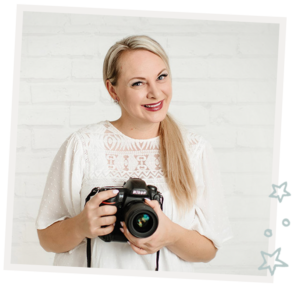
I'm
Lisa DiGeso
I’m on a mission to create uplifting online experiences for photographers ready to elevate their art, their business and their mindset.(...and have fun along the way!)

